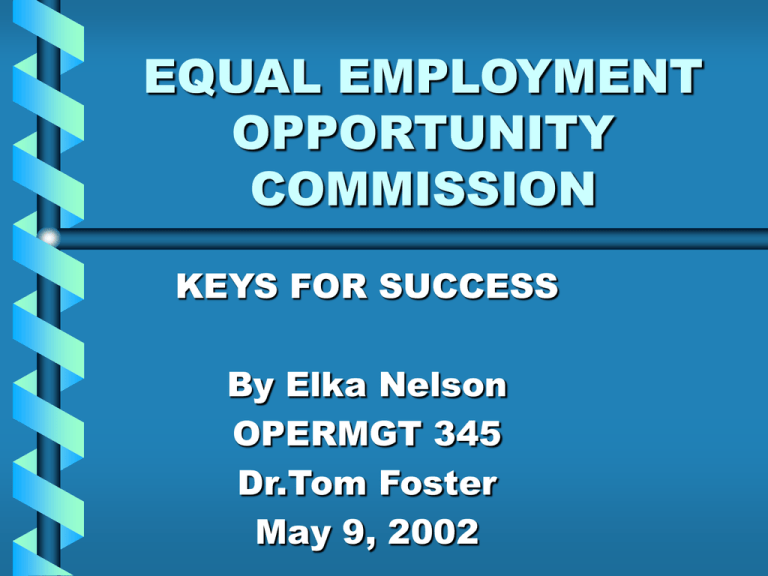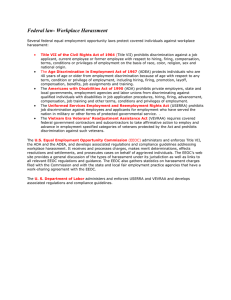EEOC OperMgt 345 Presentation
advertisement

EQUAL EMPLOYMENT OPPORTUNITY COMMISSION KEYS FOR SUCCESS By Elka Nelson OPERMGT 345 Dr.Tom Foster May 9, 2002 AGENDA • • • • • • • • • • • • • EEOC History EEOC Overview Brainstorm tool The Laws Discriminatory Practices Filing a charge Mediation Process Employer Responsibilities Discrimination Facts Helpful Hints Real World Examples Summary References EEOC HISTORY • Established on July 5, 1965 by Title VII of the Civil Rights Act of 1964 for the purpose of eliminating employment discrimination in the workplace. EEOC OVERVIEW • EEOC coordinates all regulations, practices & policies. • Interprets laws, monitors employment discrimination programs. • Provides funding and support to local FEPAs. • Sponsors outreach and assistance programs. Brainstorming Tool • The information presented here can be used to educate, change existing behaviors, encourage diversity and fairness in your organization. Possible uses of this presentation: – – – – Company meetings Quizzes for employees Incoming employee training Information/awareness signs around office – Incentive Programs – No tolerance programs Title VII of Civil Rights Act of 1964 • Prohibits employment discrimination based on: – – – – – Race Color Religion Sex National Origin Age Discrimination in Employment Act of 1967 • Prohibits discrimination against: – Individuals over 40 years old Equal Pay Act of 1963 • Prohibits compensation discrimination based on: – Genders doing similar work under similar conditions Americans with Disabilities Act of 1990 • Prohibits employment discrimination based on: – disability both in the private sector, state and local government Rehabilitation Act of 1973 • Prohibits employment discrimination against: – Federal employees with disabilities Civil Rights Act of 1991 • Prohibits – providing compensation for intentional discrimination Discriminatory Practices • Hiring and firing • Compensation, assignment, or classification of employees • Transfer, promotion, layoff, or recall • Job advertisements • Recruitment • Testing • Use of company facilities • Training and apprenticeship programs • Fringe benefits • Pay, retirement plans and disability leave • Other terms and conditions of employment Who Can File a Charge? • Any individual who believes his/her employment rights have been violated. • Any individual, organization, or agency can file a charge on behalf of another person. How is a charge filed? • A charge can be filed by either mail or in person at the nearest EEOC office. • Call 1-800-669-4000 to locate your nearest EEOC office. What Information must be provided? • Complaining party’s name, address and telephone number • Name of employer and basic information • Description of the alleged violation • Dates of the alleged violation(s) What are the time limits for filing? • 180 days form alleged violation • 300 days if charge is covered by state or local anti-discrimination law • Contact EEOC immediately upon suspected discrimination What happens after a charge is filed? • May be assigned investigation • Seek to settle charges • Seek information by interviews, review documents and visit facilities • Mediation • Dismissal Mediation Process • Fair and Neutral • Saves Time and Money • Confidential • Avoids Unnecessary Litigation What are the employers responsibilities? • The remedies for employment discrimination may include: – – – – – – – – – Back pay Hiring Promotion Reinstatement Front pay Reasonable accommodation Attorney fees Expert witness fees Court costs Facts About National Origin Discrimination • Speak English Only Rule • Accent • Harassment • Immigration-related practices Facts About Age Discrimination • Apprenticeship Programs • Job Notices and Advertisements • Pre-Employment Inquiries • Benefits • Waivers of ADEA rights Facts about Pregnancy Discrimination • Hiring • Pregnancy and Maternity Leave • Health Insurance • Fringe Benefits Facts About Religious Discrimination • Hiring • Firing • And other terms and conditions • Reasonably accommodate the religious practices of employees Facts About Race/Color Discrimination • Race-Related Characteristics and Conditions • Harassment • Segregation and Classification of Employees • Pre-Employment Inquiries Facts About Compensation Discrimination • Skill • Effort • Responsibility • Working Conditions • Establishment Facts About the Americans with Disabilities Act • An individual with a disability is a person who: – Has a physical or mental impairment – Has a record of an impairment – Is regarded as having an impairment Facts About Sexual Harassment • The conduct has to be sufficiently frequent or severe and cause a hostile work environment or result in “employment action” such as hiring, firing, promotion, or demotion. • Federal law does not prohibit simple teasing, offhand comments, or isolated incidents that are not serious. Helpful Hints • • • • • • • • • • • Eliminate Negative Attitudes “Practice What you Preach” Eliminate derogatory jokes Offer awareness-based diversity training Offer skill-Based diversity training Implement affirmative action plans Promote policies that discourage sexual harassment Provide physical access for employees with physical disabilities Offer flexible days of for religious holidays Offer parental leaves Post the laws and company policies More Helpful Hints • Strong support from the top levels of the organization. • Clear and consistent application of diversity principles in personnel decisions. • Diversity-focused organizational policies. • Appropriate reward systems and accountability. • Access to resources to support training and other activities. • Fairness to all. • Regular monitoring and evaluation. Real World Examples • 1993 the Washington State Supreme Court upheld a $389,000 judgment against a Seattle bank brought by a Cambodian-American who was fired because of his accent. • An employee was awarded $572,000 for being fired while missing work due to cancer recovery. Summary By educating yourself, staff and company with this information and taking an active role in eliminating discrimination in the workplace you will be able to attract and retain skilled employees, increase productivity, job satisfaction and encourage diversity and cohesiveness. References • U.S. Equal Employment Opportunity Commission publications – Facts About National Origin Discrimination – Facts About Age Discrimination – Facts About Pregnancy Discrimination – Facts About Religious Discrimination – Facts About Race/Color Discrimination – Facts About Compensation Discrimination – Facts About the Americans with Disabilities Act – Facts About Mediation – Questions and Answers on Employer Liability for Harassment by Supervisors – Mediate-Employment Discrimination Charges – US EEOC: An Overview – The Law – 35 Years of Ensuring the Promise of Opportunity – Federal Laws Prohibiting Job Discrimination Questions and Answers • Introduction to Leadership Skills, for BSU Department of Management, compiled by Chris Baughn and John D. Bigelow (2000)



